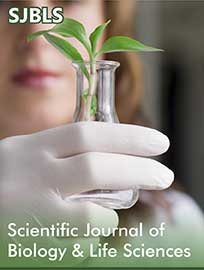 Research Article
Research Article
Anti-Fatigue and Exercise Performance Improvement Effects of Orally Supplementation of a Concentrate Novelly Composed of Traditional Chinese Medicinal Plants Extracts – A Vivo Investigation and a Mechanism Study
Xuyan Ding, Xunyun Wang, Xiaowei Jia, Zichun Qiu and Yan Li1*
R&D Center, Shanghai Tong Han Chun Tang Health Technology, Shanghai, China
Yan Li, R&D Center, Shanghai Tong Han Chun Tang Health Technology, Shanghai, China
Received Date: September 20, 2024; Published Date: October 14, 2024
Summary
Fatigue is not an uncommon physiological condition for a lot of young individuals who might overwork without sufficient rest and exercise. This also leads to unsatisfactory performance in a lot of sport activities for these young individuals. In our study, a novel and edible HAN CHUN ZAI ZAO Ginseng Concentrate composed of traditional Chinese medicinal and herbal extracts including ginseng, goji berry, polygonatum sibiricum and dendrobium officinale was investigated for their synergistic anti-fatigue effect as well as capacity to improve exercise performance. The classic rotarod test in a mice-based model showed that this formulation originated from classic “Da Bu Yuan Jian Tang” in the ancient Chinese medicine prescription “Jing Yue Quan Shu” could increase the latency to fall as well as the rolling speed to fall. After 14 days, the time duration of mice on the rotarod wheel has increased by 16% compared to that of the PBS group. The mechanisms of fatigue mitigation lie in the improved physiological metabolism such as enhanced ATP level and positive immunological regulation by the orally supplemented intervention. For the medium dose group, the ATP level has improved by 40% compared to the PBS group. It was the authenticity of the medicinal herbs, modern processing technology and scientific compatibility that made the formulation outperform others. It was also the unprecedentedly formulation through a synergistic (Junchenzuoshi) and molecular manner that solved the adverse effects of ginseng in fireness (Shanghuo). In general, HAN CHUN ZAI ZAO Ginseng Concentrate could provide a valuable and safe daily supplement for young individuals who are bothered by fatigue as well as want to improve their performance in various sport activities.
Introduction
Fatigue syndrome is a serious and prevalent worldwide health problem affecting billions of people due to a lot of reasons. First, fatigue accompanies many illnesses such as aging, depression and cancers while its pathophysiology and etiology remain unclear. Near a quarter of patients suffered from fatigue as inevitable issue a in adult primary-care and ambulatory clinics [1]. Also, individuals may be vulnerable to excessive exercise that causes fatigue and even physiological stress and damage [2]. Apart from those circumstances, one reason from fatigue lies in the hectic life including 996 work paradigm and overuse of electronic devices. Energy drinks (EDs) have been widely consumed among young people in China, but the extensive use of EDs also affects the sleep and exercise of adolescents. A self-administered questionnaire for a total of 4608 adolescents assessing EDs use history, knowledge and attitude towards EDs showed 67.56% of them believed that EDs had adverse effects on health [3].
In recent decades, physicians, physiologists and even consumers have been sparing no efforts in looking for natural, active and edible compounds that can mitigate and postpone fatigue and accelerate fatigue recovery for individuals. One of a popular ready-to-drink beverage known for almost every Chinese is a caffeinated drink called Red Bull due to its anti-fatigue effect. However, consumers have already started looking for alternative anti-fatigue drinks without caffeine that could cause serious caffeine crash, which would bring extreme feelings of tiredness, drowsiness, irritation and mind distraction [4]. Rhodiola L. enriched in salidroside has been used in quite a few food supplements for anti-fatigue function [5]. However, excessive use of Rhodiola L. products could result in hypoglycemia, which consequently compromises fatigue recovery and even lead to prolonged fatigue [6]. Thus, the advantages and effectiveness of herbal based supplements should not compromise their safety priority.
A lot of scientific advances have been reported on anti-fatigue treatment with TCM, indicating that it has gradually become a hotspot to investigate the effects of TCM on sports fatigue elimination and sports ability enhancement in China [7]. Compared to Western medicine therapy with side-effects and high expenses [8], TCM therapy has clear effect and barely causes side effects, which has attracted worldwide attention [9]. In our study, a novel and edible HAN CHUN ZAI ZAO Ginseng Concentrate composed of traditional Chinese medicinal and herbal extracts including ginseng, goji berry, Polygonatum sibiricum and Dendrobium officinale was investigated for their synergistic effect of anti-fatigue and its safety.
Materials and Methods
Testing product and Treatment
A novel and edible HAN CHUN ZAI ZAO Ginseng Concentrate (GC1) composed of traditional Chinese medicinal and herbal extracts including ginseng, goji berry, Polygonatum sibiricum and Dendrobium officinale. An appropriate amount of GC1 solution was taken and diluted by physiological saline. The high-dose group did not require dilution.
Animals
Adult C57 BL/6J male mice (4-month-old, 18–22 g body weight) used in this study were housed in groups of five to eight per cage and allowed free access to food and water. A controlled environment regarding temperature, humidity and light with a 12 h light–dark cycle was maintained through the experimentation. The experimental procedures were in accordance with the Guidelines for Proper Conduct of Animal Experiments by the Science Council of China and all experiment were approved by the Ethics Review Committee for Animal Experimentation to minimize the number of animals and their suffering.
The mice were randomly divided into a normal control group, a blank control group, a low-dose GC1 group (3.75 mL/ kg), a medium dose GC1 group (7.5 mL/kg), and a high-dose GC1 group (15 mL/kg), with 8 mice in each group. The normal control group was not treated, while the blank control group mice were orally administered with PBS at a volume of 0.15 mL/10 g. They were gavaged once a day for 2 consecutive weeks. All mice were free to eat and drink. There are also a single low-dose GC1 group (3.75 mL/kg) and a single high-dose GC1 group (15 mL/kg), with 8 animals in each group. There was only one oral administration for 0.15 mL/10 g.
Rotarod Test
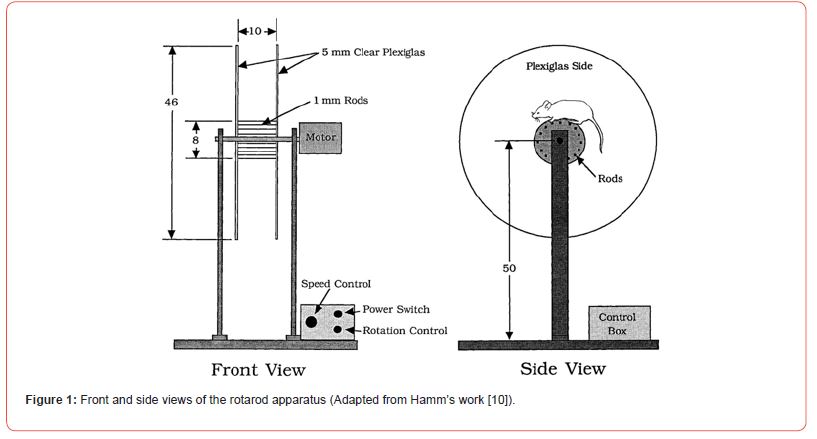
To assess the acquisition of skilled behavior in mice, we first modified the standard rotarod test to emphasize the learning aspect of the test and minimize the other factors. A rotarod machine with automatic timers and falling sensors (Shanghai Xinruan Information Technology Co., Ltd., XR-6C) were used (Figure 1). The mouse was placed on a 9 cm diameter drum. The surface of the drum was covered with hard chloroethylene, which does not permit gripping on the surface. Before the training sessions, the mice were habituated to stay on the stationary drum for 3 min to enhance their adaptability on the spinning rod fatigue tester. The latency to falling was recorded automatically by photo-cells and the total latencies on the rod was analyzed. The speed of the rod of 3 cm diameter was accelerated from 4 to 40 rpm. For all the groups, rod rotation test was performed and data was recorded twice a week [11,12].
Detection of ATP content in skeletal muscle
After anesthesia, the mice were euthanized by removing their necks. Blood was collected from the heart and allowed to coagulate at room temperature for 2-3 hours. The blood was then centrifuged at 6000 rpm for 8 minutes at 4°C. The supernatant was collected to obtain a serum sample, which was stored at -80°C for future use. Also, the skeletal muscles of the hind limbs were collected and rapidly frozen in liquid nitrogen before being stored at -80℃ for future use. After third-party frozen section, ATP enzyme staining was performed, referring to the instructions of ATP detection kit [13].
Statistical analysis
All data were analyzed using GraphPad Prism 8 statistical software. One-way ANOVA for analysis of variance between multiple groups was performed, with p<0.05 indicating statistically significant differences. (*p<0.05, **p<0.01).
Results
The exercise performance of mice after orally supplemented juice was characterized by rotarod test. Compared to the performance of mice on the equipment at day 0, it became better at day 14 regarding the time duration on the wheel for all the groups, due to the gradual adaptation of mice to the “game” on the wheel. However, it is still not difficult to observe that at day 14 the time duration on the wheel has increased by 16% for high dose group compared to PBS group (Figure 2).
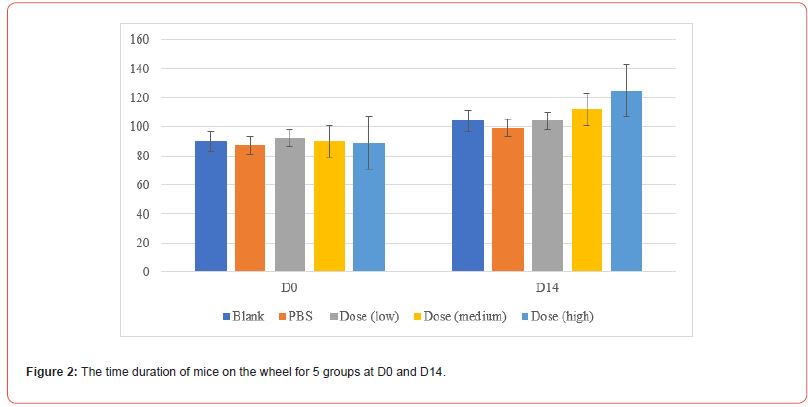
Here we have picked out data from high dose group regarding the time duration of mice on the wheel from day 0 to day 14. At day 7, the exercise performance of mice has significantly started improving compared to that at day 0 (Figure 3). Also, there is an upward trending of enhanced exercise performance starting from day 7 lasting until the last day of the experiment. It was high believed the performance improvement lied in not only the gradual adaptation but also the oral supplementation of GC1.
The significantly improved exercise performance can be explained by the enhanced ATP level in the mice skeletal muscle during the 14 days’ supplementation period. Especially for medium dose, the ATP level has increased by 40% compared to that of the PBS group (Figures 4 and 5).
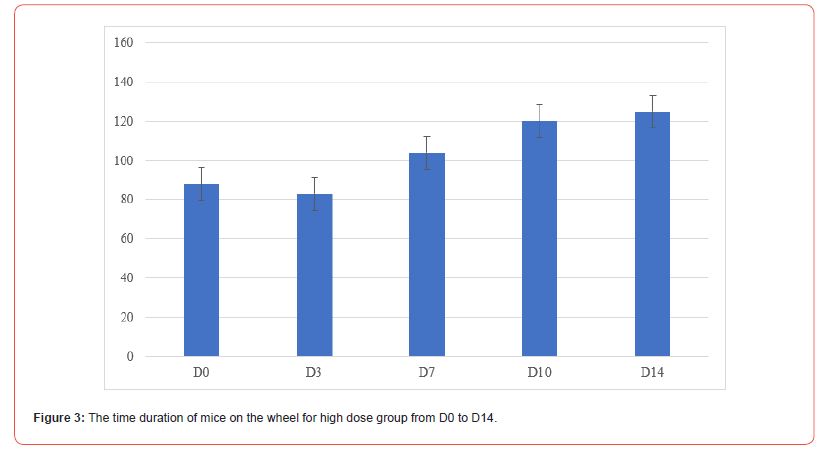
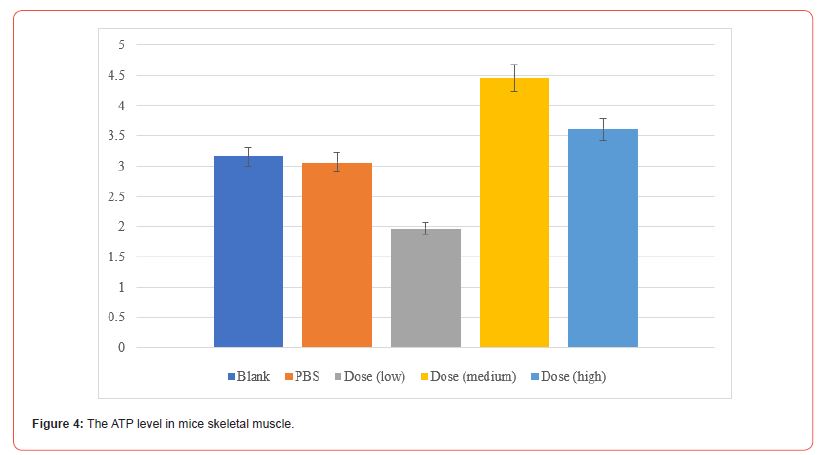
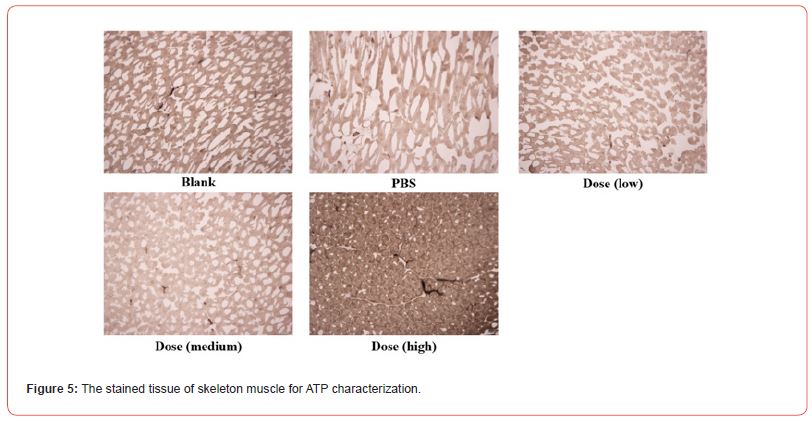
Discussion and Conclusion
In our study, the latency to fall for mice orally supplemented with GC1 had significantly increased compared to the PBS control, indicating the product’s effectiveness in ameliorating fatigue and boosting performance in the long run.
First, it was the authenticity of a Chinese herbal and medicinal plant such as ginseng regarding its plant species and cultivation location that made it more bioactive than that from other locations. Changbai Mountain ginseng (Panax ginseng C.A. Mey, CMG), a wild ginseng that grows in the Changbai Mountain Range in Jilin Province, the highest mountains (2750 m) in Northeastern China, has been used as a traditional Chinese medicine for more than a century for the reason that it contains more bioactive components including ginsenosides, volatile oils, polyphenols, flavonoids, polysaccharides and so on [14]. In GC1, the extract of 3 g Changbai Mountain ginseng with 413 mg/100g total ginsenoside absolutely guaranteed the function of its improvement in exercise performance and energy utilization.
Although there are already different traditional Chinese herbal species in boosting body energy, the combination of different species may provide enhanced efficacies, resulting from synergistic effect targeting at multiple biological pathways. Glycogen is regarded as an important source of energy in daily life. Increased breakdown and consumption of glycogen in muscle and liver has been related to elevated fatigue [15]. CMG extract supplementation improved exercise performance and energy utilization, and decreased fatigue-associated parameters in vivo [16]. On the other hand, under an anaerobic condition such as intense exercise during a short time, glycolysis becomes the main energy source, resulting an accumulation of blood lactic acid (BLA) in the muscle tissue and blood and thus causing fatigue [17]. Lycium barbarum polysaccharides could quickly remove the BLA and postpone the appearance of fatigue [18].
Malfunctioned immune system such as redundant and inactive immune cells and cytokines production could also lead to fatigue syndrome [19,20]. Tiepishihu, the stem of Dendrobium officinale, has been used as a health tea herb in East Asia for a long time because it can nourish Yin, supply body fluids, strengthen immunity, and benefit gastric tonicity according to the traditional Chinese medicine theory [21]. The marker for authentic D. officinale is a unique polysaccharide (glucomannan, called DOP) that exceeds 30% of the dry herb by weight [22]. DOP showed immunomodulating effects given significantly increased the cell variability of T lymphocytes and B lymphocytes. Also, the unique and dominant polysaccharide DOP of D. officinale has stronger antifatigue activity than Rhodiola rosea extract.
People in China are often concerned about a series of mild adverse effects such as insomnia, dizziness, dysphoria and dryness of mouth and eyes, which are commonly known as “Shanghuo” according to traditional Chinese medicine (TCM) theory after the long-term use or overdose of ginseng [23]. Beyond its hot property according to the TCM theory, it is the alterations from aspects of energy metabolism, the endocrine, immune and cardiovascular systems that cause “Shanghuo”. Ginseng is an adaptogen of a lot of acidic polysaccharides that can modulate the immune system by upregulating levels of TNF-α, IL-1β, IL-6 and interferon-γ (IFN-γ), leading to a classic clinical symptom of “Shanghuo” as oral ulcers and an inflammatory state in intestinal mucosa [24]. Polygonatum sibiricum had an anti-inflammatory activity by the inhibition of nitric oxide (NO), inducible nitric oxide synthase (iNOS), and tumor necrosis factor-alpha (TNF-α) protein expression in a lipopolysaccharide stimulated vitro study [25]. In a mouse model with Sjogren’s syndrome Dendrobium officinale polysaccharides (20 mg/mL) not only could attenuated the immune-mediated inflammation by reducing the expression of proinflammatory cytokines like tumor necrosis factor-alpha (TNF-α), interleukin-1 beta (IL-1β), and IL-6, but also could maintain the balance of inflammatory cytokines [26] (Figure 6).
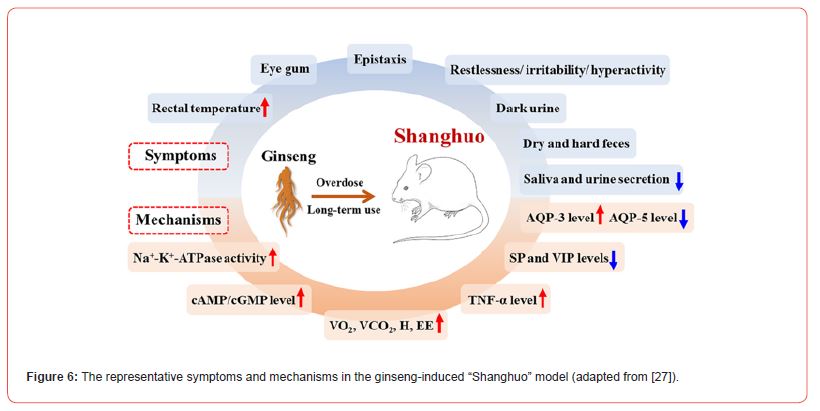
To sum up, a novel and edible HAN CHUN ZAI ZAO Ginseng Concentrate composed of traditional Chinese medicinal and herbal extracts including ginseng, goji berry, polygonatum sibiricum and dendrobium officinale can potentially and valuably target for young individuals who are bothered by fatigue and want to have better performance in various sport activities. The advantageous aspects of authentic Chinese traditional medicine with multiple biological targeted pathways, modern processing technology and scientific compatibility by synergistic compound formulation outperformed other similar supplements regarding enhanced efficiencies as well as no side effects such as Shanghuo.
References
- Kroenke K, Wood DR, Mangelsdorff AD, Meier NJ, Powell JB (1988) Chronic fatigue in primary care. Prevalence, patient characteristics, and outcome. JAMA 260(7): 929-934.
- Ament W, Verkerke GJ (2009) Exercise and fatigue. Sports medicine 39(5): 389-422.
- Luo R, Fu R, Dong L, Du Z, Sun W, et al. (2021) Knowledge and prevalence of energy drinks consumption in Shanghai, China: a cross-sectional survey of adolescents. General psychiatry 34(3): e100389-e100395.
- Antonio J, Newmire DE, Stout JR, Antonio B, Gibbons M, et al. (2024) Common questions and misconceptions about caffeine supplementation: what does the scientific evidence really show?. Journal of the International Society of Sports Nutrition 21(1): 2323919-2323923.
- Ishaque S Shamseer L, Bukutu C, Vohra S (2012) Rhodiola rosea for physical and mental fatigue: a systematic review. BMC complementary and alternative medicine 12(1): 70-72.
- Darbinyan V, Kteyan A, Panossian A, Gabrielian E, Wikman G, et al. (2000) Rhodiola rosea in stress induced fatigue--a double blind cross-over study of a standardized extract SHR-5 with a repeated low-dose regimen on the mental performance of healthy physicians during night duty. Phytomedicine: international journal of phytotherapy and phytopharmacology 7(5): 365-371.
- Zhou SS, Jiang JG (2019) Anti-fatigue Effects of Active Ingredients from Traditional Chinese Medicine: A Review. Current medicinal chemistry 26(10): 1833-1848.
- Liu C, Huang Y (2016) Chinese Herbal Medicine on Cardiovascular Diseases and the Mechanisms of Action. Frontiers in pharmacology 7(1): 469-471.
- Shen CY, Jiang JG, Yang L, Wang DW, Zhu W (2017) Anti-ageing active ingredients from herbs and nutraceuticals used in traditional Chinese medicine: pharmacological mechanisms and implications for drug discovery. British journal of pharmacology 174(11): 1395-1425.
- Hamm RJ, Pike BR, O Dell DM, Lyeth BG, Jenkins LW (1994) The rotarod test: an evaluation of its effectiveness in assessing motor deficits following traumatic brain injury. Journal of neurotrauma 11(2): 187-196.
- Shiotsuki H, Yoshimi K, Shimo Y, Funayama M, Takamatsu Y, et al. (2010) A rotarod test for evaluation of motor skill learning. Journal of neuroscience methods 189(2): 180-185.
- Lubrich C, Giesler P, Kipp M (2022) Motor Behavioral Deficits in the Cuprizone Model: Validity of the Rotarod Test Paradigm. International journal of molecular sciences 23(19): 11342-11350.
- Zhang H, Zhao C, Hou J, Su P, Yang Y, et al. (2022) Red ginseng extract improves skeletal muscle energy metabolism and mitochondrial function in chronic fatigue mice. Frontiers in pharmacology 13(3): 1077249-1077252.
- Ma GD, Chiu CH, Hsu YJ, Hou CW, Chen YM, et al. (2017) Changbai Mountain Ginseng (Panax ginseng C.A. Mey) Extract Supplementation Improves Exercise Performance and Energy Utilization and Decreases Fatigue-Associated Parameters in Mice. Molecules (Basel, Switzerland) 22(2): 237-240.
- Vigh Larsen JF, Ørtenblad N, Spriet LL, Overgaard K, Mohr M (2021) Muscle Glycogen Metabolism and High-Intensity Exercise Performance: A Narrative Review. Sports medicine (Auckland, N.Z.) 51(9): 1855-1874.
- Cordeiro LMS, Rabelo PCR, Moraes MM, Teixeira Coelho F, Coimbra CC, et al. (2017) Physical exercise-induced fatigue: the role of serotonergic and dopaminergic systems. Brazilian journal of medical and biological research 50(12): e6432-e6438.
- Peng Y, Zhao L, Hu K, Yang Y, Ma J, et al. (2022) Anti-Fatigue Effects of Lycium barbarum Polysaccharide and Effervescent Tablets by Regulating Oxidative Stress and Energy Metabolism in Rats. International journal of molecular sciences 23(18): 10920-10925.
- Klimas NG, Broderick G, Fletcher MA (2012) Biomarkers for chronic fatigue. Brain, behavior, and immunity 26(8): 1202-1210.
- Ojo Amaize EA, Conley EJ, Peter JB (1994) Decreased natural killer cell activity is associated with severity of chronic fatigue immune dysfunction syndrome. Clinical infectious diseases: an official publication of the Infectious Diseases Society of America 18 (Suppl 1): S157-S159.
- Buchwald D, Wener MH, Pearlman T, Kith P (1997) Markers of inflammation and immune activation in chronic fatigue and chronic fatigue syndrome. The Journal of rheumatology 24(2): 372-376.
- Xu X, Zhang C, Wang N, Xu Y, Tang G, et al. (2022) Bioactivities and Mechanism of Actions of Dendrobium officinale: A Comprehensive Review. Oxidative medicine and cellular longevity 2022(1): 6293355-6293358.
- Xu J, Li SL, Yue RQ, Ko CH, Hu JM, et al. (2014) A novel and rapid HPGPC-based strategy for quality control of saccharide-dominant herbal materials: Dendrobium officinale, a case study. Analytical and bioanalytical chemistry 406(25): 6409-6417.
- Chen KJ (1981) The effect and abuse syndrome of Ginseng. Journal of traditional Chinese medicine 1(1): 69-72.
- Shin JY, Song JY, Yun YS, Yang HO, Rhee DK, et al. (2002) Immunostimulating effects of acidic polysaccharides extract of Panax ginseng on macrophage function. Immunopharmacology and immunotoxicology 24(3): 469-482.
- Cui X, Wang S, Cao H, Guo H, Li Y, et al. (2018) A Review: The Bioactivities and Pharmacological Applications of Polygonatum sibiricum polysaccharides. Molecules (Basel, Switzerland) 23(5): 1170-1173.
- Lin X, Shaw PC, Sze SC, Tong Y, Zhang Y (2011) Dendrobium officinale polysaccharides ameliorate the abnormality of aquaporin 5, pro-inflammatory cytokines and inhibit apoptosis in the experimental Sjögren's syndrome mice. International immunopharmacology 11(12): 2025-2032.
- Tan J, Zhang H, Zhang L, Xu H (2023) Ginseng and "Shanghuo" (fireness): a comprehensive review from the viewpoints of TCM theory and modern science. Food & function 14(8): 3437-3453.
-
Xuyan Ding, Xunyun Wang, Xiaowei Jia, Zichun Qiu and Yan Li*. Anti-Fatigue and Exercise Performance Improvement Effects of Orally Supplementation of a Concentrate Novelly Composed of Traditional Chinese Medicinal Plants Extracts – A Vivo Investigation and a Mechanism Study. Sci J Biol & Life Sci. 4(1): 2024. SJBLS.MS.ID.000577.
-
Physiological condition; chinese medicinal and herbal extracts; immunological regulation; unprecedentedly formulation; pathophysiology; etiology
-

This work is licensed under a Creative Commons Attribution-NonCommercial 4.0 International License.



